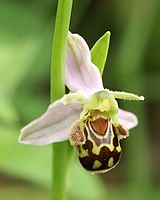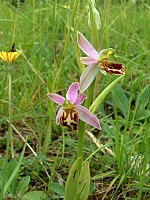Ophrys apifera
| Ophrys apifera | |
|---|---|

| |
| Scientific classification | |
| Kingdom: | Plantae |
| Clade: | Tracheophytes |
| Clade: | Angiosperms |
| Clade: | Monocots |
| Order: | Asparagales |
| Family: | Orchidaceae |
| Subfamily: | Orchidoideae |
| Genus: | Ophrys |
| Species: | O. apifera
|
| Binomial name | |
| Ophrys apifera | |
| Synonyms[1] | |
| |
Ophrys apifera, known in Europe as the bee orchid, is a
Description

Ophrys apifera grows to a height of 15–50 centimetres (6–20 in). This hardy orchid develops small rosettes of leaves in autumn that continue to grow slowly during winter. Basal leaves are ovate or oblong-lanceolate, and upper leaves and bracts are ovate-lanceolate and sheathing. Leaves exhibit parallel venation. The plant blooms from mid-April in continental Europe, but in the United Kingdom it flowers June to July. A flower spike is produced, composed from one to twelve flowers. Three large, purple sepals surround the base of the flower, which can easily be mistaken for petals. The true petals lie just above the sepals as two short, pubescent green structures protruding laterally from a central column. A third, modified petal, the labellum, sits at the bottom of the column as a landing pad for pollinators. The labellum is trilobed, with two pronounced humps on the hairy lateral lobes and a hairy median lobe having a pattern that mimics the abdomen of a bee.[3] The pattern of labellum colouration is quite variable.
The central column is an adaptation unique to orchids, in which the stamens and pistil fused together to form one central rib.[3] The anther cap can be found at the top, dorsal side of the column, while the stigma is hidden below on the ventral side. Two pollinia hang from the column over the labellum.
Distribution
Ophrys apifera is widespread across central and southern Europe, as well as North Africa and the Middle East. Its range stretches from
In the United Kingdom, it has a distinct southeastern preference, being more common in England. Recently it has been found in the southwest of England in
The genus Ophrys is the most species-rich (i.e. diverse) genus of orchids in Europe and the Mediterranean with over 200 species, according to Orchids of Britain and Europe by Pierre Delforge.
Habitat and ecology
Ophrys apifera generally grows on semi-dry turf, in grassland, on limestone, calcareous dunes or in open areas in woodland. It prefers well-drained calcareous soils, low in nutrients, in bright light or dim light.[8] It is a major colonizer of sites disturbed by human activity, such as old quarries, roadside verges and airfields.[9][10] O. apifera is one of the most likely European orchid species to establish itself within towns and cities.
In order to extract sufficient nutrients from the substrata it grows in, Ophrys apifera relies upon a symbiotic relationship with
Bee orchids are threatened by mowing during flowering, or before the seed has been released. However, they often also disappear from sites that become overgrown with shrubs and/or trees, as the orchids fail to compete with these large plants for light. For these reasons, bee orchids are often found on the edge of mown areas, beside paths or within areas that are mown very infrequently. The Sussex Wildlife Trust recommends mowing at the end of July and removing the cuttings to benefit bee orchids.[12] In prehistory, the species presumably relied upon seasonal grazing pressure, or was limited to early succession habitats and permanent grassland.

Reproduction
Ophrys apifera has been considered to preferentially practice
Phytochemistry
Floral parts display the presence of quercetin and kaempferol glycosides, which are supposed to be acylated, as well as cinnamic acid derivatives. The pink outer tepals show the presence of anthocyanins.[19][20]
Culture
The name Ophrys derives from the Greek word ophrys, meaning "eyebrow." It is believed that women in ancient Rome used to darken their eyebrows with the orchid plant, thus giving it its name.
Its root tubers were ground into a powder called salep in the Ottoman Empire, which was believed to have nutritional, medicinal, and aphrodisiac values.[23] The product's popularity spread to England in the 17th and 18th century and then to a few other European countries. Salep is still used today in medicines and traditional dishes in Turkey, which was formerly the region of the Ottoman Empire, and throughout the Middle East. It is also a popular import in the Netherlands, Cyprus, and Germany for its supposed medicinal properties.[23]
Ophrys apifera is the county flower of Bedfordshire.[24]
This species has appeared on postage stamps in many countries including
Conservation
Ecological concerns
There are local extinctions of Ophrys spp. and potentially O. apifera in Turkey and Iran due to the excessive harvesting of wild orchids to produce salep products.[23]
Since O. apifera relies heavily on its symbiotic relationship with Tulasnella fungi for survival, it is vulnerable to any chemicals, particularly fungicides, and threats which might reduce the fungi's prevalence.[21]
Species status
Protected species status in Northern Ireland.[27]
Endangered (EN) species status in Turkey, Ukraine, and Carpathian Mountains.[28][29]
Critically Endangered (CR) species status in Czech Republic and Slovakia.[28]
Laws/regulations
The Convention on International Trade in Endangered Species of Wild Fauna and Flora (CITES) named O. apifera an endangered species that is potentially an object of trade, setting strict regulations on trade of salep products.[28] Turkey, Iran, Germany, the Netherlands, and Cyprus are all Parties to CITES and, in theory, must follow those regulations.
Turkey has banned the export of true salep (salep made from an orchid root).[23]
Taxonomy
The specific evolutionary relationships between members of this genus are still poorly understood, and the best method for classifying orchid species and their variants is highly debated.[30] Some researchers propose classifying species based on their pollination tactics, while others propose classifying them based on the type of chemical emitted from the flower. A widely used and generally accepted method of classification distinguishes orchid species based on flower morphology.[30] The taxonomy of O. apifera based on this classification scheme is as follows:
Kingdom Plantae, Phylum Tracheophyta, Subphylum Angiospermae, Class Liliopsida, Order Asparagales, Family Orchidaceae, Subfamily Orchidoideae, Genus Ophyrus, Species O. apifera.
Varieties
- Ophrys apifera var. apifera
- Ophrys apifera var. bicolor
- Ophrys apifera var. botteronii
- Ophrys apifera var. friburgensis
- Ophrys apifera var. immaculata
- Ophrys apifera var. trollii
- Ophrys apifera var. fulvofusca
- Ophrys apifera var. belgarum
- Ophrys apifera var. jurana
- Ophrys apifera var. atrofuscus
References
- ISBN 9783319097015.
- ^ Royal Society – Pre-adaptations and the evolution of pollination by sexual deception: Cope’s rule of specialization revisited
- ^ a b Ray, H. & Wagner, V. (2015). “Orchid pollination biology”. Environmental Horticulture Department, UF/IFAS Extension (ENH1260). https://edis.ifas.ufl.edu/pdffiles/EP/EP52100.pdf
- ^ "World Checklist of Selected Plant Families".
- ^ "World Checklist of Selected Plant Families TDWG Geocodes" (PDF).
- ^ "The RSPB: Hodbarrow". The RSPB.
- ^ Tony Henderson (21 June 2008). "Orchid colony discovered in grass verge". journallive. Archived from the original on 21 April 2013.
- ^ a b PhD Thesis of the University of Liverpool – Diversity and Roles of Mycorrhizal Fungi in the Bee Orchid Ophrys Apifera
- ISBN 9780881928761.
- ISBN 9789075365719.
- ^ American Journal of Botany – C and N stable isotope signatures reveal constraints to nutritional modes in orchids from the Mediterranean and Macaronesia
- ^ Suffolk Wildlife Trust – Bee Orchids
- ISBN 9780521844598.
- ^ Charles Darwin (1898). The Various Contrivances by which Orchids are Fertilized by Insects (second ed.). D. Appleton and Company. p. 52.
- S2CID 1890083. Retrieved 2 September 2013.
- ISBN 0709051069.
- S2CID 1890083.
- ^ Dawkins, R. (1986) The Blind Watchmaker
- ^ Function of floral pigments in the orchid genus Ophrys. Kheim, Doris (2009), Diplomarbeit, University of Vienna (abstract)
- ^ a b Addam, K., Takkoush, J., Bou-hamdan, M., & Itani, J. (2015). Five established orchids Ophrys apifera var. Chlorantha, Aurita, Purpurea, Purpurea. F. Alba. and Flavescens (Orchidaceae) in Lebanon as part of the native flora. Journal of Ecology and Environmental Sciences, 6(2), 163–169. ISSN: 0976-9900 & E-ISSN: 0976-9919
- ^ WORDS Latin-to-English Dictionary by William Whittaker, AbleMedia Classics Technology Center, accessed 2014-11-13
- ^ JSTOR 4256222
- ^ Plantlife website County Flowers page Archived 2015-04-30 at the Wayback Machine
- ^ Google Images – Bee orchid postal stamp
- ^ Norvic Philatelics – Charles Darwin
- ^ Jackson, M. W., FitzPatrick, U., Cole, E., Jebb, M., McFerran, D., Sheehy Skeffington, M., & Wright, M. (2016). Ireland Red List No. 10: Vascular Plants. National Parks and Wildlife Service, Department of Arts, Heritage, Regional, Rural, and Gaeltacht Affairs, Dublin, Ireland.
- ^
- ^ ISSN 0031-9422.
External links
 Media related to Ophrys apifera at Wikimedia Commons
Media related to Ophrys apifera at Wikimedia Commons Data related to Ophrys apifera at Wikispecies
Data related to Ophrys apifera at Wikispecies- Biolib
- Ophrys apifera
- Ophrys apifera | Plants of the World Online
- Orchids of Britain and Europe








